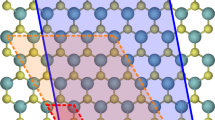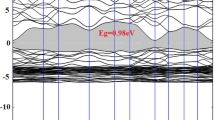Abstract
We have used a quasichemical formalism to calculate the native point defect densities in x = 0.22 Hg1−xCdxTe and CdTe. The linearized muffin-tin orbital method, based on the local density approximation and including gradient corrections, has been used to calculate the electronic contribution to the defect reaction free energies, and a valence force field model has been used to calculate the changes to the vibration free energy when a defect is created. We find the double acceptor mercury vacancy is the dominant defect, in agreement with previous interpretations of experiments. The tellurium antisite, which is a donor, is also found to be an important defect in this material. The mercury vacancy tellurium antisite pair is predicted to be well bound and is expected to be important for tellurium antisite diffusion. We consider the possibilities that the tellurium antisite is the residual donor and a Shockley-Read recombination center in HgCdTe and suggestions for further experimental work are made. We predict that the cadmium vacancy, a double acceptor, is the dominant defect for low cadmium pressures, while the cadmium interstitial, a double donor, dominates at high cadmium pressures.
Similar content being viewed by others
References
CF.Wan, M.C. Chen, J.H. Tregilgas, T.W. Orent and J.D. Luttmer, 1993 MCT Workshop.
H.R. Vydyanath, J. Ellsworth, J.J. Kennedy, B. Dean, C.J. Johnson, G.T. Neugebauer, J. Sepich and P.-K. Liao,J. Vac. Sci. Technol. B 10, 1476 (1992).
H.R. Vydyanath,J. Electrochem. Soc. 128, 2609 (1981).
F.A. Kroger,The Chemistry of Imperfect Crystals (New York: J. Wiley & Sons, Inc., 1964).
T. Tung, M.H. Kalisher, A.P. Stevens and P.E. Herning,Mat. Res. Soc. Symp. Proc. 90, 321 (1987) and references therein.
O.K. Andersen, O. Jepsen and D. Glotzel,Highlights of Condensed Matter Theory, éd. F. Bassani et al. (Amsterdam, The Netherlands: North Holland, 1985), p. 59.
D. Langreth and D. Mehl,Phys. Rev. B 28, 1809 (1983).
M. van Schilfgaarde, A.T. Paxton, M.A. Berding and M. Methfessel (in preparation).
M.A. Berding, M. van Schilfgaarde and A. Sher,Phys. Rev. B 50, 1519 (1994).
In Ref. 9, we assumed degeneracies of one, two, and one for the neutral, singly, and doubly ionized states of all donor and acceptors in HgCdTe. This is valid if only the a, states are occupied and the triply (sixfold including spin) degenerate t2 states remain unoccupied. (Recall that the point group of an undistorted point defect is Td.) If the t2 states are partially occupied, an additional degeneracy will be present that should be included in our calculations; this degeneracy was not included in Ref. 9 but will be added in this paper. For an undistorted defect with the full Td symmetry, this degeneracy arises from the partial occupation of the sixfold degenerate state (constrained to have a maximal number of spins paired); if the local symmetry is lowered due to a Jahn-Teller distortion (to point group D2d for one or two electrons in the t2 state, to point group C2v for three, four, or five electrons in the t2 state),11 this additional degeneracy arises from the extra degree of freedom present in the introduction of a locally preferred direction in space. Going through the counting, we obtain degeneracy factors of (6,3,6,3,6,1) for one to six electrons in the t2 state, respectively. Results reported here include these full degeneracy factors.
See, for example, the discussion of symmetry-lowering distortions in silicon in G.A. Baraff, E.O. Kane and M. Schlüter,Phys. Rev. B 21, 5662 (1980).
S.L. Holander and C.R. Helms, private communication.
H.R. Vydyanath and C.H. Hiner,J. Appl. Phys. 65, 3080 (1989).
G.L. Hansen and J.L. Schmit,J. Appl. Phys. 54,1639 (1983).
G.L. Hansen, J.L. Schmit and T.N. Casselman,J. Appl. Phys. 53, 7099 (1982).
H.F. Schaake, J.H. Tregilgas, J.D. Beck, M.A. Kinch and B.E. Gnade,J. Vac. Sci. Technol. A 3,143 (1985); H.F. Schaake,J. Electron. Mater. 14, 513 (1985).
J.L. Meléndez and C.R. Helms,J. Electron. Mater. 22, 999 (1993).
See, for example, R. Sporken, M.D. Lange, S. Sivanathan and J.P. Faurie,Appl. Phys. Lett. 59, 81 (1991).
C.E. Jones, V. Nair and D.L. Polla,Appl. Phys. Lett. 39, 248 (1981).
C.E. Jones, V. Nair, J. Lindquist and D.L. Polla,J. Vac. Sci. Technol. 21, 187 (1982).
C.E. Jones, K. James, J. Merz, R. Braunstein, M. Burd, M. Eetemadi, S. Hutton and J. Drumheller,J. Vac. Sci. Technol. A 3, 131 (1985).
R. Schiebel and D. Bartholomew,J. Electron. Mater. 24,1299 (1995).
See, for example, D.A. Stevenson and M.-F.S. Tang,J. Vac. Sci. Technol. B 9, 1615 (1991).
C.L. Littler, E. Maldonado, X.N. Song, Z. Yu, J.L. Elkind, D.G. Seiler and J.R. Lowney,J. Vac. Sci. Technol. B 10,1466 (1992).
J.L. Elkind,J. Vac. Sci. Technol. B 10, 1460 (1992).
W.C. Hughes, M.L. Swanson and J.C. Austin,Appl. Phys. Lett. 59, 938 (1991);J. Electron. Mater. 22, 1011 (1993).
Because of the low zinc concentrations, our results should be applicable to x = 0.04 Cd1−xZnxTe, which is the more recent substrate of choice for LWIR Hg0.8Cd0.2Te devices.
The Jahn-Teller distortion most certainly exists at low temperatures. At high temperatures corresponding to liquid phase growth, these disortions may get washed out by thermal vibrations in the lattice. We are currently examining this issue.
P. Höschl, R. Grill, J. Franc, P. Moravec and E. Belas,Mat. Sci. and Engr. B16, 215 (1993).
Author information
Authors and Affiliations
Rights and permissions
About this article
Cite this article
Berding, M.A., Sher, A. & Van Schilfgaarde, M. Defect modeling studies in HgCdTe and CdTe. J. Electron. Mater. 24, 1127–1135 (1995). https://doi.org/10.1007/BF02653064
Received:
Revised:
Issue Date:
DOI: https://doi.org/10.1007/BF02653064




